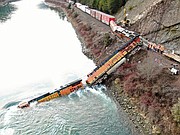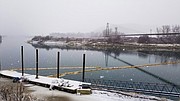Derailment work shifts from containment to clean up efforts
MOYIE SPRINGS — A multi-agency response has been in full effect with regard to containment and clean up of hazardous materials as a result of the Jan. 1 BNSF Railway train derailment due to a rockslide.
Representatives from the U.S. Environmental Protection Agency (EPA), the Idaho Department of Environmental Quality (DEQ), the Kootenai Tribe of Idaho, BNSF, Idaho Department of Fish and Game, and authorities from both Boundary County and the City of Bonners Ferry have been working diligently to monitor, clean up, and reclaim the spilled and leaking fluids from the derailed locomotives still in the river and on the riverbank.
BNSF dispatched contractors to the scene immediately following the derailment to ascertain the problems and hazards concerning the locomotive that was submerged within the river.
On Thursday, Jan. 2, BNSF placed containment booms in the river in an attempt to catch any hazardous material, such as diesel fuels leaking from the locomotive. By this time, the DEQ sent two field responders to the scene as well.
That same day, the Kootenai Tribe shut down the water intakes, located in the river near to the Twin Rivers Campground, in an effort to protect the fish hatchery from hazardous materials.
“Hatchery 1 at the mission, currently has no back up, the year class of sturgeon has been transferred to the twin rivers facility. They are settled in and enjoying the larger tanks,” said Gary Aitken Jr., Chairman for the Kootenai Tribe of Idaho. “The twin rivers facility (hatchery 2) has switched to the Moyie River and well water intake lines.”
Per the EPA update on the derailment, on Friday, Jan. 3, BNSF personnel had cleared the track of all of the railroad cars except for the three locomotives.
“BNSF has deployed about 2,700 feet of containment booms in the river and continues to add more where needed to isolate and absorb small pockets of petroleum products up and down an approximately 10-mile stretch of the Kootenai River between Bonners Ferry and the leaking locomotive,” said Boundary County Emergency Management and Public Information Officer, Director Andrew O’Neel.
Per the EPA update, containment boom was placed in order to attempt to catch leakage from travelling further downriver, and the Idaho Department of Fish and Game reported that fish and wildlife has not been impacted “thus far.”
The immediate response of all agencies involved, the strategic work completed, and ongoing to contain hazardous materials from causing detriment to fish, wildlife, and flora of the area has proved successful.
Per a recent update memo sent from representatives, Bill Dunbar (EPA) and Gus Melonas (BNSF), as of Tuesday, Jan. 7, BNSF contractors have removed fuel from the locomotive that was derailed and stopped on the riverbank.
The contractors have also placed a total of 6,250 feet of containment boom downstream of the accident. Skimmers have collected approximately 150 gallons of the spilled diesel fuel.
“Preliminarily, diesel fuel is the only contaminant that leaked into the river,” said Mike Glazier, Fire Chief of Paradise Valley Fire. “BNSF will extract the escaped fuel with vacuum trucks and compare the total amount leaked into the river, to the amount recovered to determine the volume of fuel that will affect the surrounding ecosystems.”
EPA representative Dunbar reported on the containment progress and the minimal amount of environmental impact that has been determined as of this time.
“Given the significant amount of boom in place, this indicates relatively little diesel or other petroleum products has been released thus far,” Dunbar said. “Boomed locations include four sensitive fish and wildlife habitat areas, and — out of an abundance of caution — near the town of Bonners Ferry, some eight river miles downstream of the wreck.”
“The residential water supplies for residents of Bonners Ferry and the surrounding areas are not affected by the fuel spill, as they do not pull water from the Kootenai,” O’Neel said.
The update, from Dunbar and Melonas, also mentioned that divers have started a delicate process of removing the 1,900 gallons of diesel fuel, along with other petroleum products, from the locomotive still in the river, and that the process will potentially take another several days.
“Boundary County officials have placed a restriction on boating… and continue to ask for the public’s cooperation in staying off the river to allow the over three dozen emergency responders and cleanup personnel to work unimpeded during this crucial environmental cleanup period,” O’Neel stated.
In order to ensure the safety of the community and the integrity of the emergency response and clean up efforts, the Boundary County Board of Commissioners have drafted and disseminated an amended emergency order; Disaster Emergency Declaration, dated Jan. 6.
The amended order details the events of the derailment and past activities regarding the emergency response efforts. The amendment speaks to the unanimous vote of the Boundary County Board of Commissioners to extend the emergency ordinance/declaration until Feb. 8.
This extension details that “all non-motorized boat traffic is hereby prohibited from the Deep Creek Boat Launch east to the State of Montana border for this extended period of time...the Rocky Point Boat Launch is also closed to all non-emergency vehicles and boats during the day period.”
County officials ask that the community please abide by the closure of this area, of the Kootenai River, and cease any boat traffic so that the environmental cleanup efforts may continue without issue.





